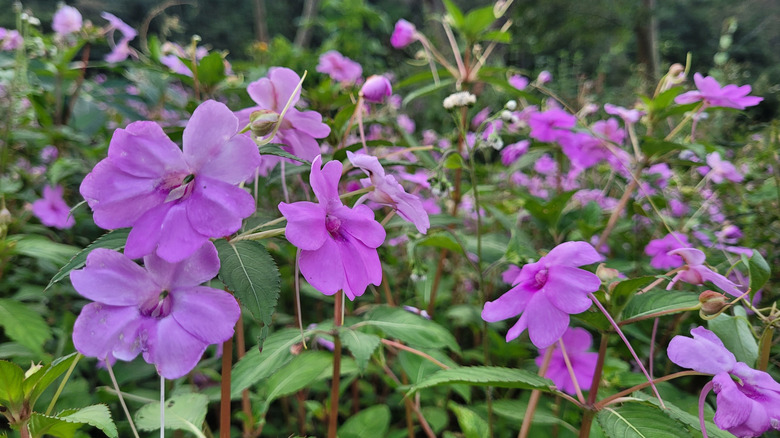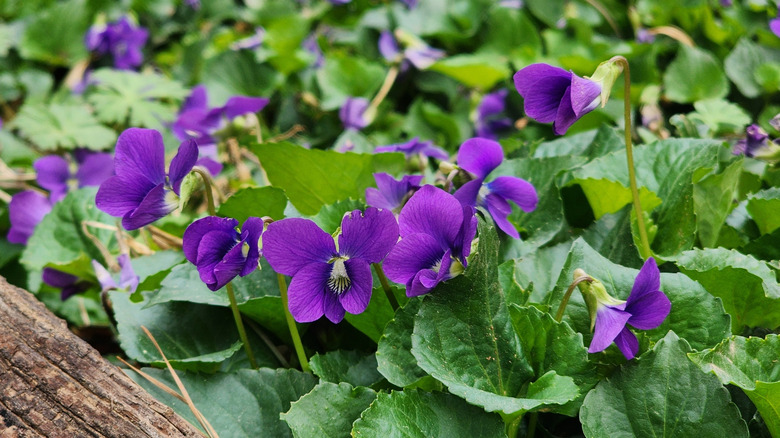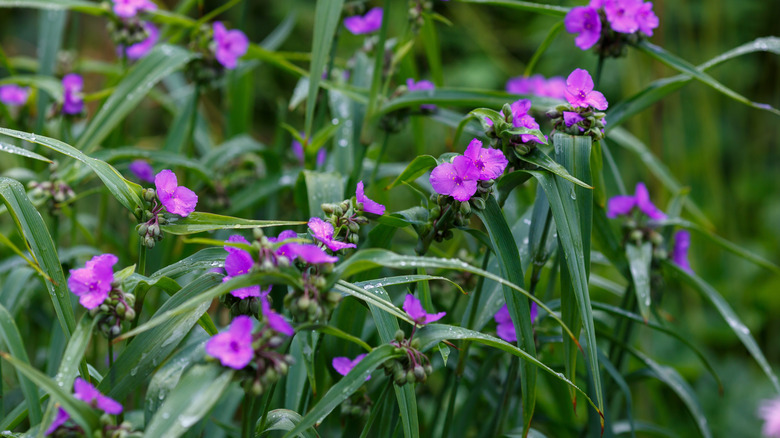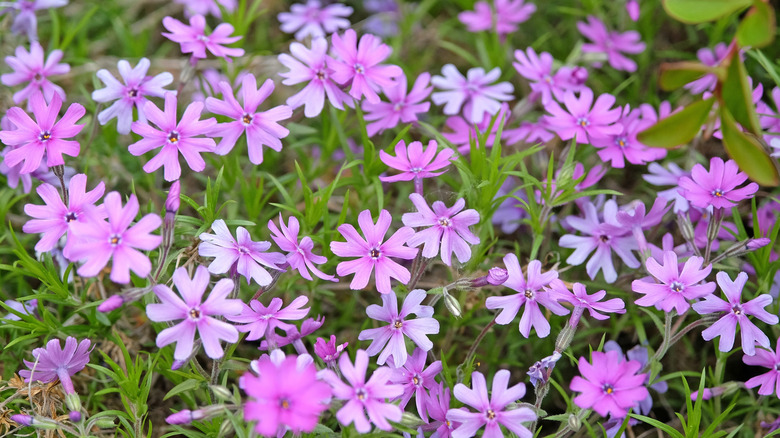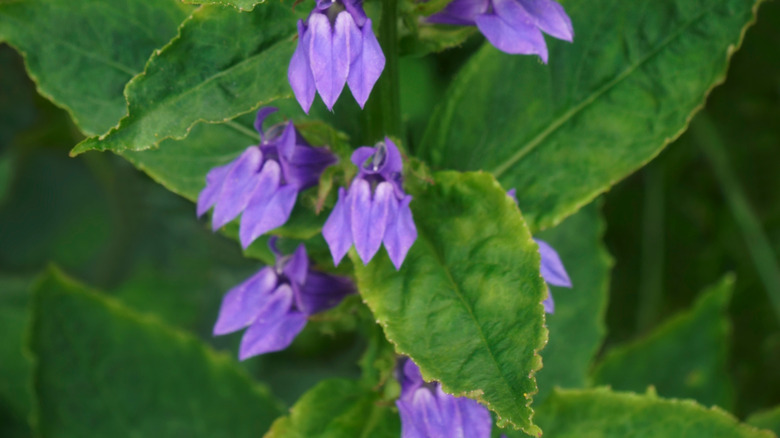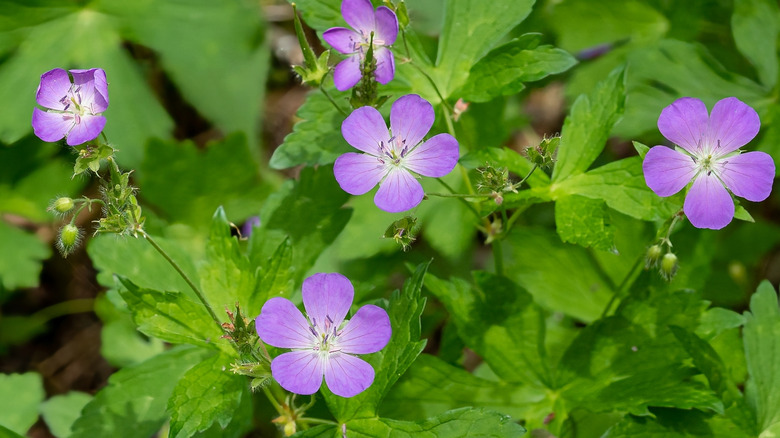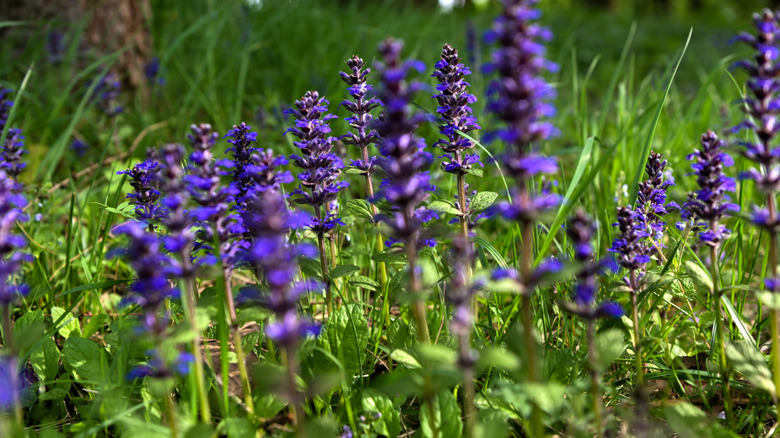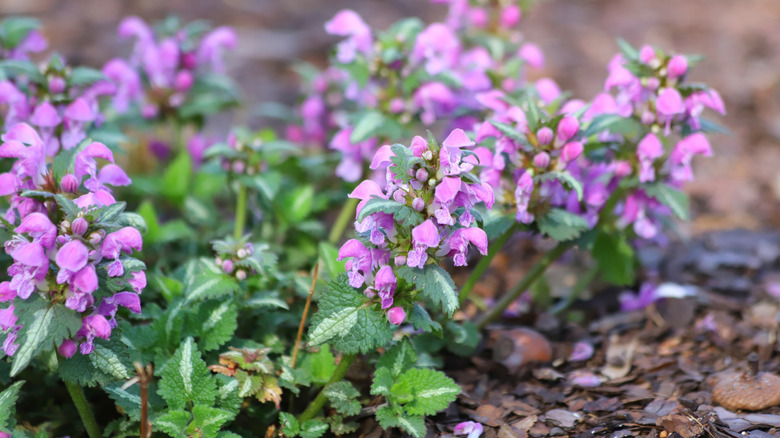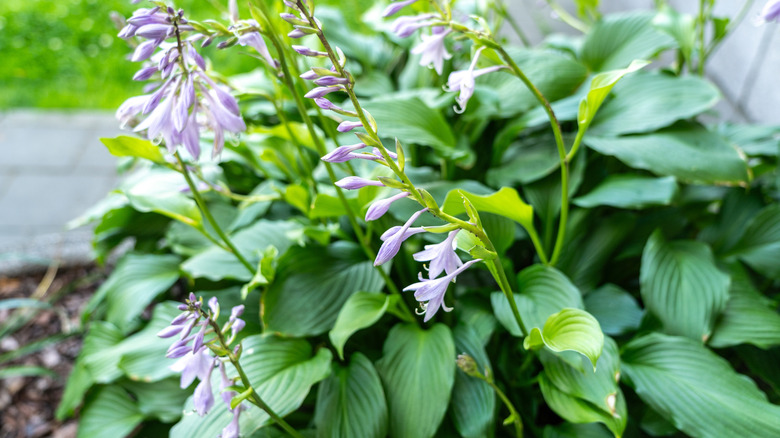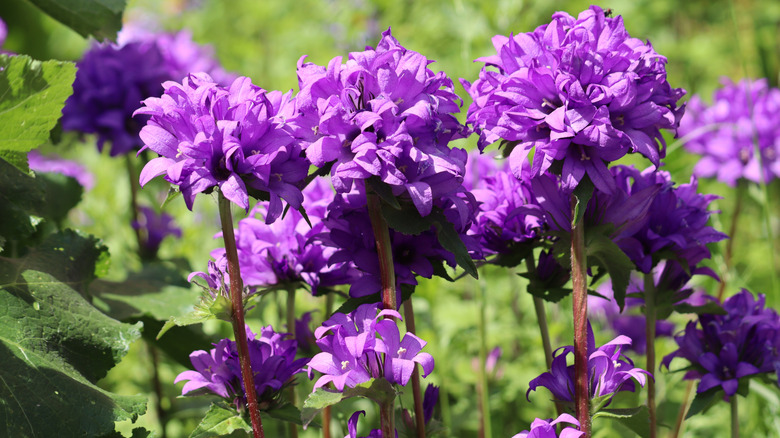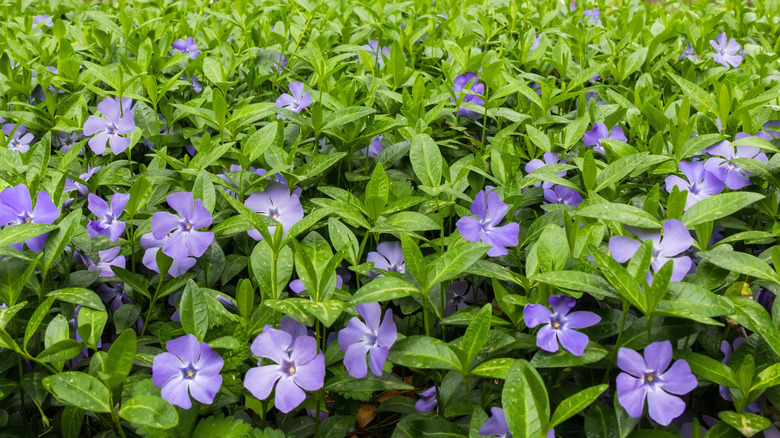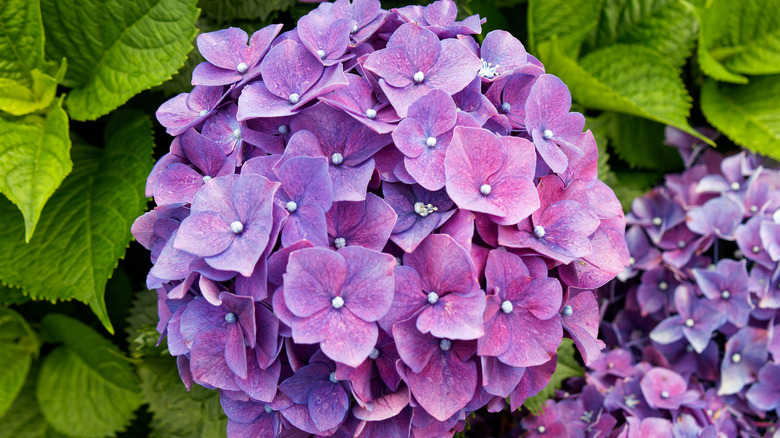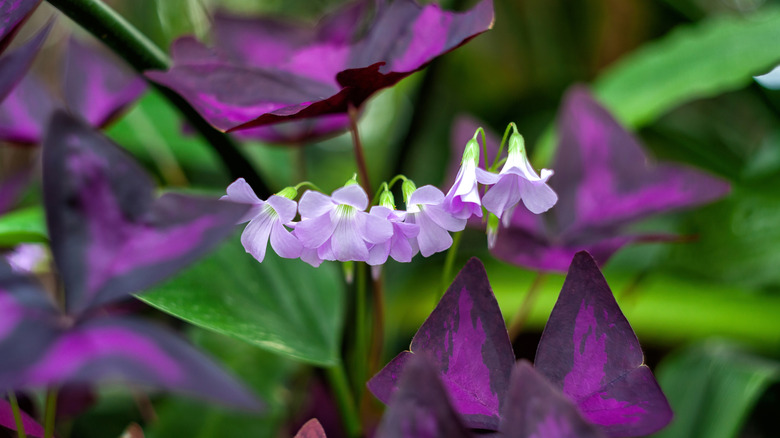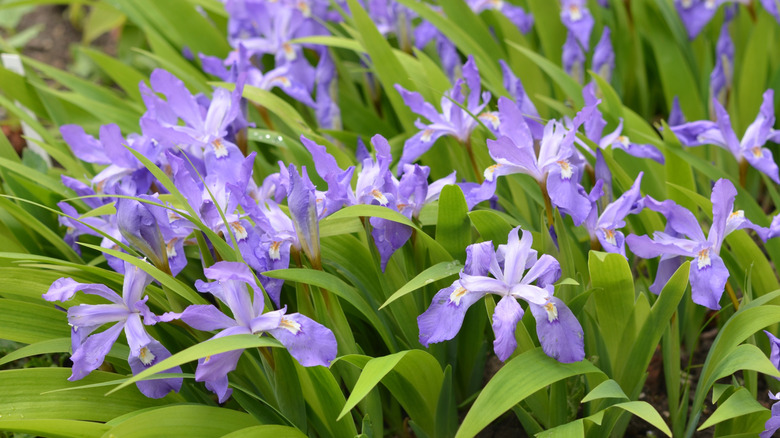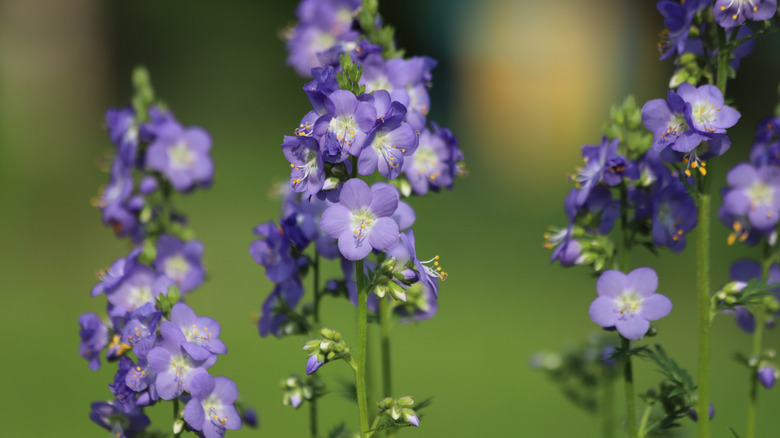16 Best Fast-Growing Purple Plants For A Beautiful Shade Garden In No Time
Just because you have a shady garden or backyard doesn't mean you can't quickly fill it with color. Purple is often associated with creativity and sophistication, so it's perfect for creating an intriguing atmosphere that also feels inviting. Plus, because it's on the opposite side of green on the color wheel, it naturally adds a pop of contrast against the leaves and lawn. Because there are so many shades to choose from, you can use purple to complement nearly any landscape. Varieties with reddish-toned flowers provide an added warmth that's perfect for brightening up the area, while bluish-purple flowers create a more calming feel.
It's not always easy to find fast-growing purple plants that thrive in shade, but you might be surprised by how many options are out there. Whether you're looking for natives, perennials, ground covers, or shrubs, there's something for everyone. They come in all shapes, sizes, and growing habits, so you can easily add more drama to a rock garden, create a dynamic container garden, or fill in a shady border. If you're not sure where to start, below are some pretty purple plants, like impatiens, hostas, creeping phlox, and bigleaf hydrangeas, that are happiest when growing in the shade, so you can fill your garden with color in no time.
Wishbone flowers
If you're looking to quickly fill your shade garden with color, wishbone flower (Torenia fournieri) is a must-have. They're profuse bloomers that erupt with two-toned violet flowers that last from mid-summer through frost. Hummingbirds are especially fond of them, though they'll have a variety of pollinators buzzing around your garden. Add them to hanging baskets, containers, or a shady border to add pops of purple. Torenia is winter-hardy in zones 10 and 11, but in most regions, it's grown as an annual. These low-maintenance beauties thrive in rich, well-drained soil and prefer partial to full shade.
Impatiens
Impatiens (Impatiens walleriana) are famous for their fast growth and profusion of blooms that last from spring to frost. Although considered annuals outside of zones 10 to 11, they readily self-seed and often pop back up the following year. These plants will fill your garden with a variety of butterflies and look stunning in containers, along pathways, or in shaded beds. Impatiens are one of the few flowers that truly thrive in shade, and too much sun can actually burn their leaves. For the best growth, plant them in well-drained, slightly acidic soil enriched with organic matter.
Common blue violet
If you want a purple flowering groundcover that makes a stunning grass alternative, look no further than common blue violet (Viola sororia). This native perennial puts out bluish-violet blooms at the beginning of spring that attract butterflies, bees, and other pollinators. In summer, it produces cleistogamous flowers, which are petalless and don't open. Hardy in zones 3 to 7, this plant thrives in rich soil and dappled sun or shade, though it can tolerate a range of light and soil conditions. It is low-maintenance and spreads rapidly, making it perfect for trickier areas of the garden.
Spider lily
Spider lilies (Tradescantia virginiana) are beautiful flowers that grow perfectly in shade, and they also attract pollinators like bees and butterflies throughout the season. Their dainty, blue violet, or lavender blooms emerge in early spring and last through summer or fall. They're extremely low-maintenance and can grow in several environments, including shadier areas of yards in zones 4 to 9. Spider lily plants will happily grow whether you stick them in full sun or deep shade. They aren't picky about soil either, easily growing in poor or heavy clay, though they do best in moist, fertile soils.
Creeping phlox
For another ground cover plant that loves shade, you can't go wrong with creeping phlox (Phlox stolonifera). It's a pretty, low-growing native that produces a mat of fragrant, lavender flower clusters that invite hummingbirds and butterflies to your yard from mid-summer to frost. You can use creeping phlox to help control erosion on slopes, add color to rock gardens, or brighten up the edges of shady flower beds. This ground cover thrives in zones 5 to 8 in slightly acidic, well-drained soil in partial shade.
Blue cardinal flower
With its bluish-lavender flower clusters, blue cardinal flower (Lobelia siphilitica) is sure to make guests do a double-take. Also called great lobelia, this fast-growing native graces your garden with showy blooms from mid-summer to frost. It's the perfect plant for wildlife lovers who want to see more hummingbirds and butterflies flitting around their pollinator garden. This lobelia thrives in partial shade or dappled sun and fertile, loamy soil. As a moisture-lover, it makes the perfect addition to a shady rain garden. You can grow this eye-catching native in zones 4 to 9.
Cranesbill
Cranesbill (Geranium maculatum) is a rapidly growing wildflower that will have birds and butterflies flocking to your yard. The pretty, light purple flowers last all spring to provide nectar for pollinators, and songbirds will stop by to snack on the seeds in summer. This 1- to 2-foot-tall plant makes an attractive ground cover when planted in mass, and fits in beautifully with woodland gardens. It grows best in a shaded area in organically rich, loamy soil and can tolerate dry conditions. Because this perennial is hardy in zones 3 to 11, nearly anyone can enjoy its low-maintenance beauty.
Bugleweed
Bugleweed (Ajuga reptans) is one of the best plants for anyone who wants a quick-growing ground cover, as it takes up space rapidly, forming a dense mat that chokes out weeds. While this trait is sometimes beneficial, its aggressive spreading has led to it being classified as invasive in some regions. Find out if it's recommended in your state before you plant it. Its attractive, blue-violet flower spikes are sure to turn heads when they bloom from spring through summer. Hardy in zones 3 to 10, it's easily grown in shade and prefers wet, well-drained soil.
Dead nettle
If you're looking for a pretty plant that spreads quickly and easily, dead nettle (Lamium maculatum) might be your new favorite. Come spring, clusters of soft purple flowers appear atop attractive foliage. It has bright green leaves adorned with white or silvery splotches, though there are several cultivars to choose from with leaves that vary in variegation patterns, shapes, sizes, and textures. It grows best in shaded areas and likes humusy, well-drained soil. Dead nettle is hardy in zones 3 to 8 and may remain evergreen in areas with mild winters.
Hostas
Hostas are best known for their lush foliage, but don't overlook their stalks with purple flowers. Their trumpet-shaped blooms emerge in summer, bringing in all kinds of pollinators, including hummingbirds, butterflies, and bees. Some varieties grow more quickly than others. Fast-growing cultivars like 'Blue Cadet' and 'Lemon Lime' are popular choices for those who want to quickly fill out their garden. While all hostas are shade-lovers, blue-tinted leaf varieties tend to like more shade than their green-leaved counterparts. They thrive in rich, slightly acidic soil and are hardy in zones 3 to 9.
Clustered bellflower
When looking for plants for an English cottage garden, it's hard not to consider clustered bellflower (Campanula glomerata). It adds a dreamy burst of color in late spring with its showy clusters of rich purple, bell-shaped flowers atop tall stems. With up to 15 blooms per group, there's plenty of nectar to go around for bees, butterflies, hummingbirds, and other pollinators. They thrive in full sun to partial shade in well-drained soil, needing less sun in hot summer climates. These clumping perennials are easily grown in zones 3 to 8.
Common periwinkle
Common periwinkle (Vinca minor) is a pretty, easy-to-grow flowering plant with delicate, bluish-lavender flowers, though there is a caveat. To say it grows rapidly would be an understatement, which is why it's so popular as a ground cover plant. However, if left unchecked, it can spread aggressively and crowd out native species, especially in mild, moist climates. For that reason, it's best used in areas where its growth can be easily managed, like patio pots, hanging baskets, or raised beds. It's hardy in zones 4 to 9 and prefers partial shade and moist, sandy, well-drained soil.
Bigleaf hydrangea
Few flowering shrubs perform as well in the shade as bigleaf hydrangeas (Hydrangea macrophylla). They're prized for their exceptionally showy blooms, which may be large, rounded mophead clusters or delicate, flattened lacecap flowers, depending on the cultivar. Perhaps their most unique feature is the way their flowers get their color. If planted in alkaline soil, they get pink blossoms, while acidic soil creates blue hues. For a purple shade, plant them in soil with a pH between 5.5 and 6 for a perfectly blended mix. Bigleaf hydrangeas thrive in zones 6 to 11 in partial to deep shade.
Purple shamrock
Purple shamrock (Oxalis triangularis) is a perennial with attractive, triangular leaves that can be green or rich shades of purple, depending on the cultivar. In spring, pinkish-purple flowers emerge in clusters for another pop of color through summer. Butterflies and other pollinators will stop by to sip nectar when they're in bloom, though deer and rabbits tend to stay away. They thrive in partial sun, making them perfect for adding color and texture to hanging baskets on the patio. They're hardy in zones 8 to 11, though you can bring them indoors as houseplants during cooler months.
Dwarf crested iris
Featuring lavender flowers with golden or white crests, the dwarf crested iris (Iris cristata) is a spring-blooming native perennial that makes a stunning, low-growing ground cover or addition to a rock garden. Its large, showy blooms draw in hummingbirds and bumblebees looking for early-season nectar. Although this iris can withstand full sun with plenty of moisture, it grows best in a partially shaded area in well-drained soil. It's a low-maintenance wildflower that's easily grown in zones 3 to 9.
Jacob's ladder
Jacob's ladder (Polemonium reptans) gets its common name from the way its leaves grow. Each stem is lined with pairs of leaflets that sit across from one another, creating a pattern that looks like the rungs of a ladder. In spring, it produces clusters of bluish-purple, bell-shaped flowers that grow on slightly drooping stems. Not only are the flowers fragrant, but they're beloved by native bees. This native woodland perennial thrives in partial shade and moist, well-drained soil, and it's hardy in zones 3 to 8.


